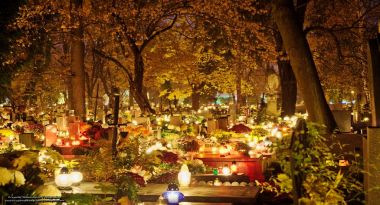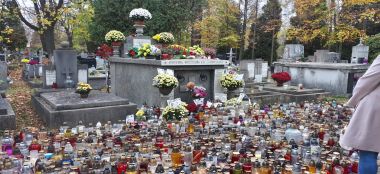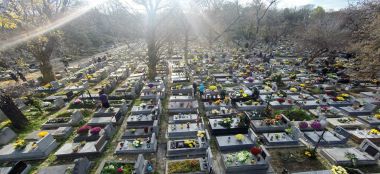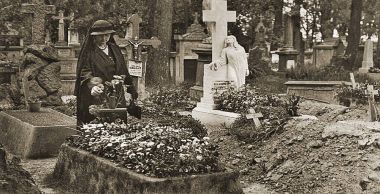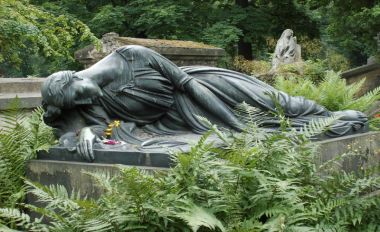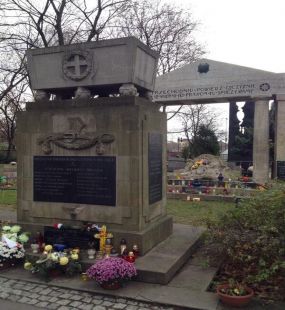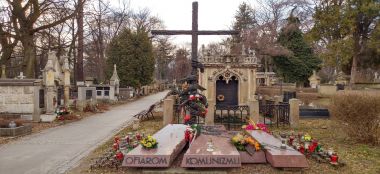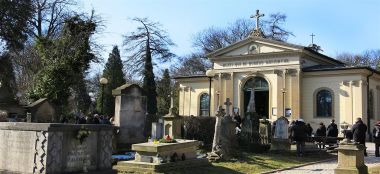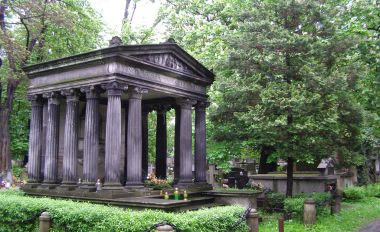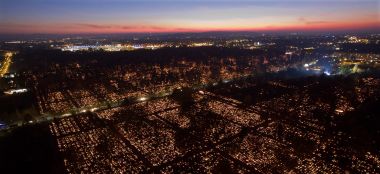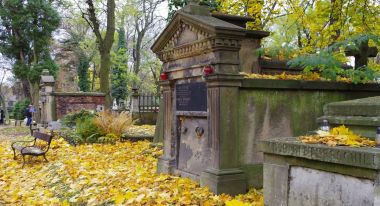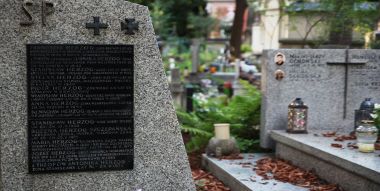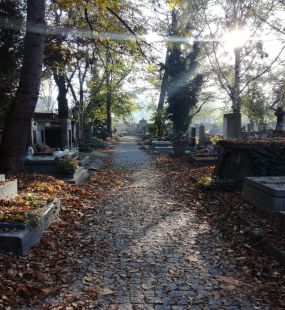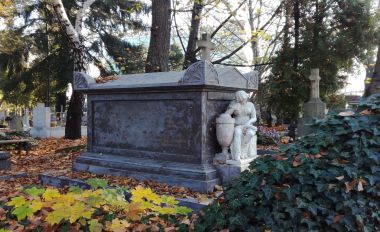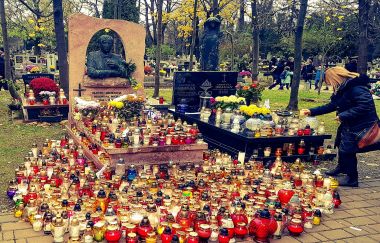Is a historic necropolis and a cultural heritage monument located on 26 Rakowicka Street in the centre of Kraków, Poland. It lies within the Administrative District No. 1 Stare Miasto meaning "Old Town" – distinct from the Kraków Old Town situated further south. Founded at the beginning of the 19th century when the region was part of Austrian empire, the cemetery was expanded several times, and at present covers an area of about 42 hectares. Many notable Cracovians, among them the parents of Pope John Paul II, are buried here.
It was laid out and arranged in the years 1800–1802 (on an area of 5.6 ha), and it was open from mid-January 1803. It was established in the then suburban Bosackie farm in the village of Prądnik Czerwony on the border of Olsza, due to the ban on burials in the so far existing church cemeteries within the city (the Josephine Edict of 1784 ). The land with an area of 10 Chełmno moray for 1150 Rhenish zlotys was purchased from the barefoot Carmelites from Czerna by the Austrian authorities. The cost of setting up the cemetery was covered by the city of Kraków and the surrounding municipalities: Rakowice, Prądnik Biały and Prądnik Czerwony, Olsza, Grzegórzki, Piaski, Bronowice Wielkie and Bronowice Małe, Czarna Wieś, Nowa Wieś, Krowodrza, and Kawiory, which were granted the right to bury the dead there. The first funeral took place in January 1803 (18-year-old Apolonia née Lubowieckie Bursikowa, who died on January 15, 1803). In 1807, a well was built, and in 1812 a large cross was funded from public contributions.
The cemetery was enlarged several times. For the first time in 1836, when another 10 acres of land were purchased from the Cherno Carmelites for 5,000. PLN. Polish. The layout of the cemetery was commissioned by the architect, director of the city construction department, Karol R. Kremer, who, in 1839, designed its park layout. The newly acquired land was consecrated on November 2, 1840. The surrounding wall was built of material obtained from the demolition of the All Saints Church.
In 1863, the town purchased 5 morgens and 1743 yards of land from the Carmelites and Walery Rzewuski, located at the western wall of the cemetery. It was consecrated in September 1866 and the burying of the dead began immediately (epidemic). Another extension of the cemetery took place in the fall of 1886 - by over 15 morgens (Jan Matejko and Maciej Jakubowski were buried in the middle of the new alley). At the turn of 1933 and 1934, the cemetery was extended to the north by the former sappers training ground (over 15 ha) to its present size (by liquidating Modrzewiowa Street).
On June 6, 1856, a permit was issued for the construction of a new chapel, but it was not until 1861–1862 that a chapel of the Lord's Resurrection (founded by Anna and Ludwik Helcl) was erected in the center of the cemetery, in place of the existing wooden one. In 1877, an administrative building and a morgue were erected according to the design of Salomon Saary.
In 1981, the Citizens' Committee for Rescuing Krakow was established, within which the commission for Rescuing Krakow's Cemeteries and the Krakow Land operates. OKRK organizes annual donations for historic tombs and tombstones. Works are carried out at the Rakowicki Cemetery and the New Podgórze Cemetery (in cooperation with the Podgórze.pl Association). OKRK collects funds for the renovation of historic tombs on a special account. The funds are used to renovate graves that do not have disposers.
It was laid out and arranged in the years 1800–1802 (on an area of 5.6 ha), and it was open from mid-January 1803. It was established in the then suburban Bosackie farm in the village of Prądnik Czerwony on the border of Olsza, due to the ban on burials in the so far existing church cemeteries within the city (the Josephine Edict of 1784 ). The land with an area of 10 Chełmno moray for 1150 Rhenish zlotys was purchased from the barefoot Carmelites from Czerna by the Austrian authorities. The cost of setting up the cemetery was covered by the city of Kraków and the surrounding municipalities: Rakowice, Prądnik Biały and Prądnik Czerwony, Olsza, Grzegórzki, Piaski, Bronowice Wielkie and Bronowice Małe, Czarna Wieś, Nowa Wieś, Krowodrza, and Kawiory, which were granted the right to bury the dead there. The first funeral took place in January 1803 (18-year-old Apolonia née Lubowieckie Bursikowa, who died on January 15, 1803). In 1807, a well was built, and in 1812 a large cross was funded from public contributions.
The cemetery was enlarged several times. For the first time in 1836, when another 10 acres of land were purchased from the Cherno Carmelites for 5,000. PLN. Polish. The layout of the cemetery was commissioned by the architect, director of the city construction department, Karol R. Kremer, who, in 1839, designed its park layout. The newly acquired land was consecrated on November 2, 1840. The surrounding wall was built of material obtained from the demolition of the All Saints Church.
In 1863, the town purchased 5 morgens and 1743 yards of land from the Carmelites and Walery Rzewuski, located at the western wall of the cemetery. It was consecrated in September 1866 and the burying of the dead began immediately (epidemic). Another extension of the cemetery took place in the fall of 1886 - by over 15 morgens (Jan Matejko and Maciej Jakubowski were buried in the middle of the new alley). At the turn of 1933 and 1934, the cemetery was extended to the north by the former sappers training ground (over 15 ha) to its present size (by liquidating Modrzewiowa Street).
On June 6, 1856, a permit was issued for the construction of a new chapel, but it was not until 1861–1862 that a chapel of the Lord's Resurrection (founded by Anna and Ludwik Helcl) was erected in the center of the cemetery, in place of the existing wooden one. In 1877, an administrative building and a morgue were erected according to the design of Salomon Saary.
In 1981, the Citizens' Committee for Rescuing Krakow was established, within which the commission for Rescuing Krakow's Cemeteries and the Krakow Land operates. OKRK organizes annual donations for historic tombs and tombstones. Works are carried out at the Rakowicki Cemetery and the New Podgórze Cemetery (in cooperation with the Podgórze.pl Association). OKRK collects funds for the renovation of historic tombs on a special account. The funds are used to renovate graves that do not have disposers.



